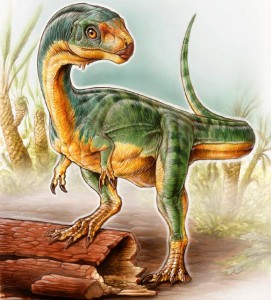V-Rex: The Most Ferocious Vegetarian Around?
 Chilesaurus diegosuarezi. Image credit: Gabriel Lio.
Chilesaurus diegosuarezi. Image credit: Gabriel Lio. The Frankenstein monster of prehistoric times has been discovered, all thanks to seven-year-old Diego Suarez. The first remains of Chilesaurus diegosuarezi were unearthed by Suarez on a trip to Patagonia with his geologist parents. He and his sister were looking for decorative rocks when he stumbled upon bone fragments belonging to a dinosaur that now bears his name. Chilesaurus diegosuarezi baffles paleontologists. According to a new study released in the journal Nature, the dinosaur is an anatomical jigsaw puzzle whose skeletal anatomy is reminiscent of multiple-unrelated dinosaurs. However that is not all—while the Chilesaurus genetically belongs to a fearsome meat-eating family, it is in fact a vegetarian.
Over time, theropods, the nearest relatives of modern-day birds, evolved from violent hunters into gentle plant eaters due to changes in geography and foliage. Before Chilesaurus was discovered, when this change occurred was unclear. At approximately 150 million years old, Chilesaurus may prove to be the missing link in dinosaur evolution, revealing that theropods adopted a meat-free diet much earlier than theorized. A beak and leaf-shaped teeth unmistakably make Chilesaurus the vegetarian in the family. But how can a theropod, cousin of two of the most notorious carnivores—Tyrannosaurs rex and Velociraptor—be an herbivore?
The answer may relate to Chilesaurus’ unusual skeletal anatomy. The hodgepodge of bones uncovered in Chile initially suggested that Suarez actually discovered the remains of multiple dinosaurs. Since then, paleontologists uncovered over a dozen Chilesaurus skeletons. The bones revealed that the average Chilesaurus was the size of a turkey. It was bipedal, had a skull, neck, and teeth similar to longneck dinosaurs, vertebrae and robust forelimbs like theropods, and a pelvic girdle similar to the ornithischian dinosaurs. No other known dinosaurs exhibited this combination of characteristics. “The most interesting [aspect] about Chilesaurus is the story that it tells about how evolution works. It is like a combination of different dinosaurs in a single species,” observed Martin Ezcurra, a researcher at the University of Birmingham, in a recent press release.
Paleontologists believe they have found reason behind Chilesaurus’ outwardly nonsensical anatomy. An article posted by the University of Birmingham on Monday notes that, “different parts of the body of Chilesaurus were adapted to a particular diet and way of life, which was similar to other groups of dinosaurs. As a result of these similar habits, different regions of the body of Chilesaurus evolved resembling those present in other, unrelated groups of dinosaurs.” This process, in which species evolve similar traits over time in order to adapt to the environment, is called convergent evolution. Paleontologists believe that Chilesaurus represents one of the most extreme cases of convergent evolution ever discovered.
One thing is clear to paleontologists—the discovery of Chilesaurus diegosuarezi demonstrates how little we understand about the diversification of dinosaur groups. “This study will force paleontologists to take more care in the future in the identification of fragmentary or isolated dinosaur bones. It comes as false relationship evidence may arise because of cases of convergent evolution, such as that present in Chilesaurus,” said Ezcurra.
The nature of science is such that it is always changing, always self-correcting, and thus always advancing. The Chilesaurus has not only challenged what paleontologists originally determined to be true in regard to theropods, but also how paleontologists perform their own work. Thanks to Diego Suarez, our perception of prehistoric evolution has been tested. Life is ever evolving and adapting, just like our understanding of it. At the very least, Chilesaurus demonstrates the importance of curiosity, adaptability, and an afternoon spent digging in the dirt.
